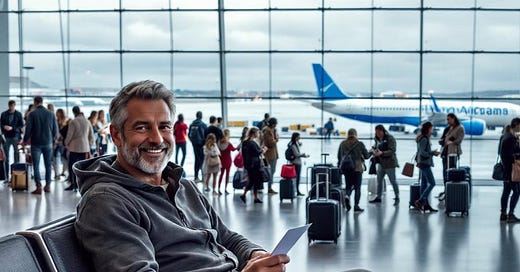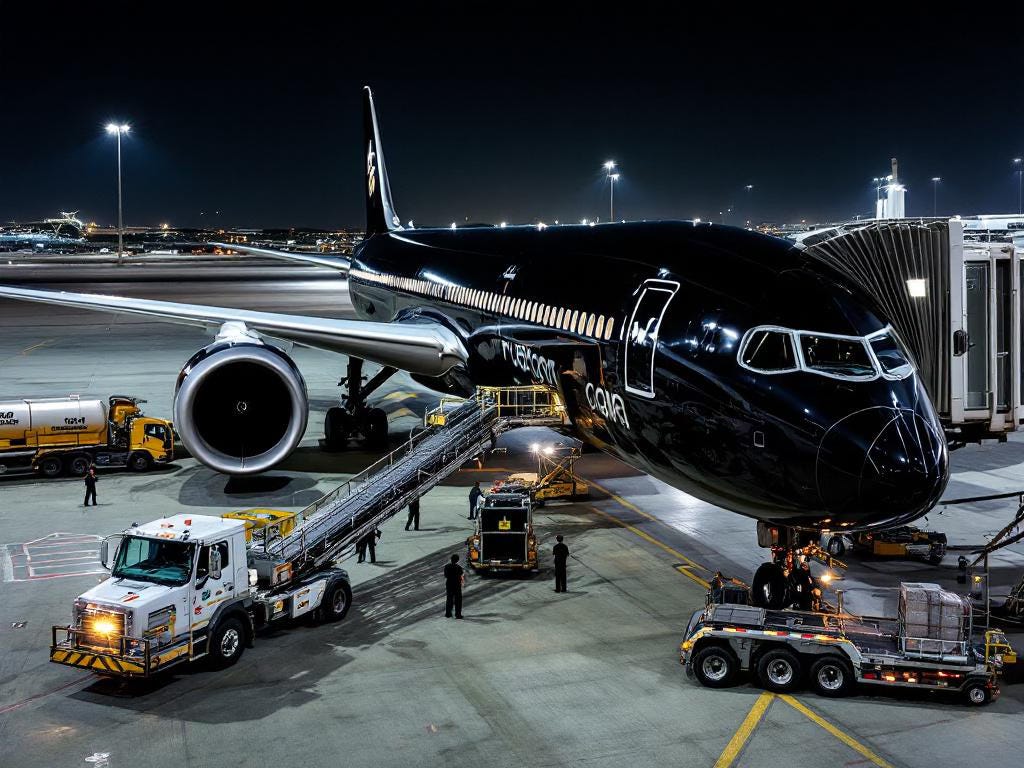The Boarding Mistake 90% of Passengers Make (And What I Do Instead as a Pilot)
Why I Never Board Through the Jet Bridge First. And Neither Should You...
You hear the gate agent's voice: "We're now boarding Group 1." Instantly, half the terminal rushes toward the jet bridge like it's Black Friday at Best Buy. Business travelers clutch their priority boarding passes. Families with crying babies push forward. Everyone's desperate to be first on that plane.
But watch carefully next time, and you'll notice something: the pilots aren't rushing.
We're still sitting calmly at the gate, maybe grabbing one last coffee, checking our phones or reading a book.
Because we know something most passengers don't…
The Jet Bridge Traffic Jam Nobody Talks About
Here's what happens when you board in that first wave: You get stuck.
Picture this: You're third in line, feeling smug about beating the crowd. You hand over your boarding pass, walk down the jet bridge, and then... you stop. Because the person ahead of you stopped. And the person ahead of them stopped too.
Why? The plane isn't ready.
The gate agent might have called boarding, but the flight attendants are still doing their safety checks. The galley isn't secured. The lavatory service truck might still be connected. Sometimes the previous flight's passengers are still deplaning through the rear door.
So there you are, trapped in a narrow jet bridge with 50-100 other people, breathing recycled air, unable to move forward or back. I've seen passengers wait 15-20 minutes just standing in that tube.
Meanwhile, I'm still at the gate, watching this unfold through the window.
The 10-15 Minute Rule at least…
Here's my secret: I wait at least a minimum of 10-15 minutes after general boarding begins.
Why 10-15 minutes? That's typically how long it takes for the initial boarding jam to clear and for the flight attendants to actually be ready to receive passengers efficiently. It's also long enough for the eager beavers to get settled so they're not clogging the aisles.
Now, this timing varies depending on the aircraft and how full the flight is. On a small regional jet with 50 seats, 5-10 minutes might be enough. On a packed A380 or 777-300, you might want to wait 20-25 minutes. A half-empty flight? The jam clears faster, so 5-6 minutes works. But a minimum of 10-15 minutes is my sweet spot for most domestic flights on mainline aircraft. Again this depends on the load and the boarding process efficiency.
During those 15 minutes, I'm doing something most passengers never think to do: watching the ground crew.
The Ground Crew Tells You Everything
While you're staring at your phone or fighting for a power outlet, I'm watching the ballet happening outside. Here's what I look for:
The baggage carts: If they're still loading bags, the flight isn't ready. Period. Those cargo doors need to be closed and the weight-and-balance paperwork completed before we can even think about pushback.
The fuel truck: Still connected? We're not going anywhere soon. Fueling can take 20-30 minutes on a big aircraft.
The catering truck: If they're still loading meals, the galley isn't ready for passengers.
The lavatory service truck: This is the big one. If that blue truck is still connected to the aircraft, the lavatories aren't available. Guess what happens when passengers board and immediately need the bathroom?
Maintenance personnel: If I see mechanics around the aircraft or maintenance trucks still connected, there might be a technical issue being resolved. Sometimes airlines start boarding even when there's a risk they'll have to deplane everyone if the problem can't be fixed quickly.
The Counter-Intuitive Benefits
Boarding later isn't just about avoiding the jet bridge jam. Here's what else happens:
Better overhead bin space: Sounds crazy, right? But think about it. The first boarders stuff their carry-ons anywhere they can find space often not above their own seats. When I board, I can see exactly where the gaps are.
Faster seat access: Those early boarders are still standing in the aisles, rearranging their belongings, helping others with bags. When I walk on, they're mostly settled, and I can get to my seat without playing human Tetris.
Less germ exposure: This one's become more important since 2020. That jet bridge is basically a petri dish when it's packed with people breathing on each other for 15 minutes. I'd rather spend that time in the well-ventilated terminal.
Lower stress: There's something zen about watching the chaos instead of being part of it. I board when I'm ready, not when the gate agent says I should be ready.
The flight feels shorter: Here's something nobody considers when you board first, you're sitting on that plane for an extra 20-30 minutes waiting for everyone else to board. That's 20-30 minutes of feeling trapped, listening to overhead bins slam, and watching the departure time tick by. When I board late, I sit down and we're pushing back within 5-10 minutes. Psychologically, the flight experience feels much shorter because my "time on aircraft" is mostly actual flying time, not sitting-around-waiting time.
What About Overhead Bin Space?
"But what if there's no room for my bag?" This is the number one concern I hear.
Here's the truth: The panic about overhead bin space is mostly overblown.
I've rarely seen passengers forced to gate check properly sized carry-ons because they boarded later. It can happen on completely packed flights when bins are truly full, but it's much less common than people fear and when it does happen, the gate-check is free. Sometimes, if you're lucky, the cabin crew will find space for your bag in crew storage areas or other compartments passengers don't have access to though this isn't something you can count on. The anxiety about bin space drives far more stress than the actual reality.
The Sweet Spot Strategy
So what's my exact strategy? Here it is:
Stay at the gate until I see the ground crew finishing up
Walk confidently but not urgently down the jet bridge
Keep my boarding pass ready but don't rush the gate agent
Board with purpose, I know exactly where my seat is and where my bag is going
The result? I'm on the plane, seated, and relaxed while other passengers are still shuffling around trying to get organized.
When This Strategy Doesn't Work
Full transparency: there are times when you should board early:
Airlines with open seating (like Southwest) where you don't have an assigned seat
Small regional aircraft where overhead space really is limited
When you're traveling with small children who need extra time to get settled
First or business class on long-haul flights when you have a lie-flat seat and the crew is offering pre-departure refreshments, that extra 30 minutes becomes part of the premium experience you paid for.
But here's where the strategy becomes even MORE important:
Bus boarding at remote gates: Some airports still use buses to transport passengers to aircraft parked on remote stands. The first buses are always packed like sardine cans, while the last bus often has plenty of space and gets you to the plane just as efficiently. Plus, you might arrive to find they haven't started the APU (auxiliary power unit) yet to cool the cabin, meaning instead of waiting in an air-conditioned terminal, you're literally cooking in a metal tube with no air conditioning until all passengers board and they finally start the engines or APU.
But for your typical domestic flight? The rush to board first is just unnecessary stress.
The Real Secret
After thousands of flights as both a pilot and deadheading passenger, here's what I've learned - believe me, I've spent a lot of my life boarding airplanes: The goal isn't to be first on the plane - it's to minimize your time sitting in a packed aircraft.
I want to board, sit down, and hear "flight attendants prepare for departure" within minutes. Not sit there for 20-30 minutes watching people struggle with overhead bins, listening to crying babies, and breathing recycled air while we wait for the last passenger to find their seat.
But here's what makes this strategy even more valuable: Air traffic delays and slot restrictions. In Europe especially, we often get ground delays or have to wait for our departure slot even after everyone's boarded. Sometimes we'll board passengers then sit at the gate for 30-45 minutes waiting for our turn. When you board last, you minimize this waiting time in a packed aircraft and reduce your total "trapped on the plane" experience.
The plane doesn't leave without you if you have a confirmed seat. That mad dash to be first on board? It's just trading waiting in a comfortable terminal for waiting in a cramped metal tube.
The next time you're at the gate and hear that boarding announcement, try this: Stay seated. Watch the initial rush. Give it 10-15 minutes. Then board like you own the place.
Your fellow passengers might give you looks like you don't know what you're doing. Little do they know, you're the only one in the terminal who actually does.
What's your boarding strategy? Are you a rush-to-the-gate person, or do you have your own secret timing? Drop a comment and let me know, I'm curious if any other travelers have figured this out.
Pilot Nick
✈️ Lessons from the Flight Deck
📬 Get more cockpit insights and travel tips, subscribe free to Lessons From the Flight Deck for weekly updates that help you fly calm and confident or visit:









First mistake is buying a plane ticket.
I rarely have a carry-on and book an aisle seat. I wait for everyone to board and then I go